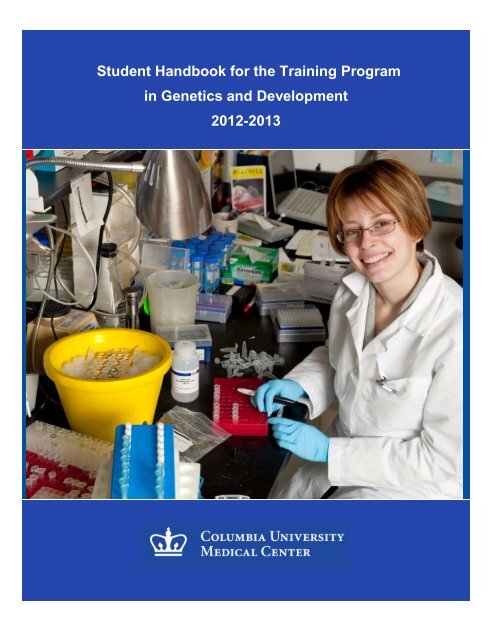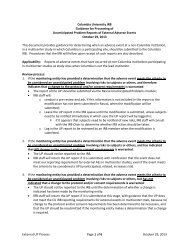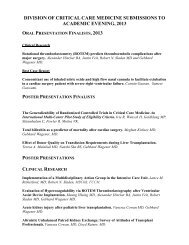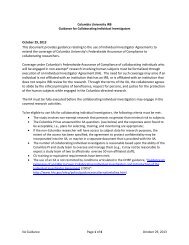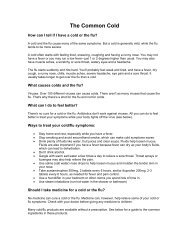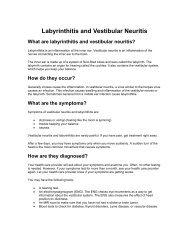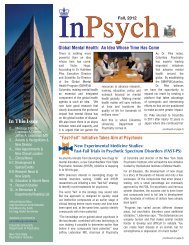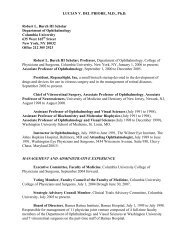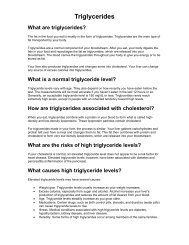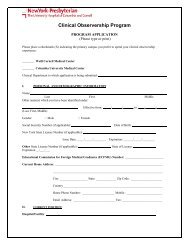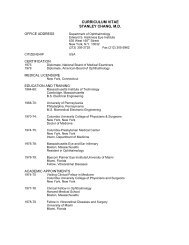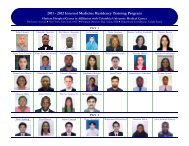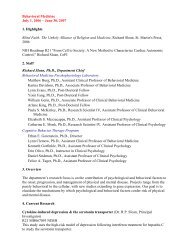Student Handbook for the Training Program in Genetics and ...
Student Handbook for the Training Program in Genetics and ...
Student Handbook for the Training Program in Genetics and ...
Create successful ePaper yourself
Turn your PDF publications into a flip-book with our unique Google optimized e-Paper software.
<strong>Student</strong> <strong>H<strong>and</strong>book</strong> <strong>for</strong> <strong>the</strong> <strong>Tra<strong>in</strong><strong>in</strong>g</strong> <strong>Program</strong><br />
<strong>in</strong> <strong>Genetics</strong> <strong>and</strong> Development<br />
2012-2013
Table of Contents<br />
Organization <strong>and</strong> Adm<strong>in</strong>istration of <strong>the</strong> Graduate <strong>Tra<strong>in</strong><strong>in</strong>g</strong> <strong>Program</strong>s at Columbia<br />
University Medical Center (CUMC) ......................................................................................................... 3<br />
History of <strong>the</strong> Department <strong>and</strong> <strong>the</strong> <strong>Genetics</strong> <strong>and</strong> Development <strong>Tra<strong>in</strong><strong>in</strong>g</strong> <strong>Program</strong> .........................4<br />
The <strong>Tra<strong>in</strong><strong>in</strong>g</strong> Faculty .....................................................................................................................................5<br />
The <strong>Genetics</strong> <strong>and</strong> Development <strong>Tra<strong>in</strong><strong>in</strong>g</strong> <strong>Program</strong> ................................................................................6<br />
Rotations ...............................................................................................................................................7<br />
Registration...........................................................................................................................................7<br />
Required <strong>and</strong> Elective Courses ...........................................................................................................8<br />
Sem<strong>in</strong>ar Series .................................................................................................................................... 13<br />
Qualify<strong>in</strong>g Exams<br />
Part I ......................................................................................................................................... 12<br />
Part II ........................................................................................................................................... 13<br />
Composition of <strong>the</strong> Qualify<strong>in</strong>g Committee ............................................................................... 13<br />
Thesis Research Preparation <strong>and</strong> Defense ..................................................................................... 15<br />
Thesis Research Advisory Committee (TRAC) .................................................................... 15<br />
Ph.D. Thesis Format .............................................................................................................. 15<br />
Composition of <strong>the</strong> Thesis Defense Committee .................................................................. 16<br />
Dissertation Defense ............................................................................................................. 16<br />
Degrees Awarded .............................................................................................................................. 16<br />
Fund<strong>in</strong>g .............................................................................................................................................. 16<br />
The Departmental Retreat .......................................................................................................................... 17<br />
Graduate <strong>Student</strong> Life ................................................................................................................................ 19<br />
Graduate <strong>Student</strong> Organization (GSO) .............................................................................................. 19<br />
Campus Hous<strong>in</strong>g <strong>and</strong> Facilities ......................................................................................................... 19<br />
<strong>Student</strong> Health Services ..................................................................................................................... 21<br />
2
<strong>Tra<strong>in</strong><strong>in</strong>g</strong> <strong>Program</strong> <strong>in</strong> <strong>Genetics</strong> <strong>and</strong> Development 2012<br />
Organization <strong>and</strong> Adm<strong>in</strong>istration of <strong>the</strong> Graduate <strong>Tra<strong>in</strong><strong>in</strong>g</strong> <strong>Program</strong>s at<br />
Columbia University Medical Center (CUMC)<br />
Welcome to <strong>the</strong> <strong>Tra<strong>in</strong><strong>in</strong>g</strong> <strong>Program</strong> <strong>in</strong> <strong>Genetics</strong> <strong>and</strong> Development at Columbia University Medical<br />
Center. We are part of <strong>the</strong> Coord<strong>in</strong>ated Doctoral <strong>Program</strong>s <strong>in</strong> Biomedical Sciences at <strong>the</strong> Health<br />
Sciences Campus of Columbia University <strong>in</strong> <strong>the</strong> City of New York <strong>in</strong> <strong>the</strong> Basic Cell <strong>and</strong> Molecular<br />
Biology group of programs, which <strong>in</strong>cludes <strong>Genetics</strong> <strong>and</strong> Development, Biochemistry <strong>and</strong><br />
Molecular Biophysics, Cell Biology, <strong>and</strong> Microbiology, Immunology <strong>and</strong> Infection. These<br />
<strong>Program</strong>s emphasize research <strong>and</strong> tra<strong>in</strong><strong>in</strong>g <strong>in</strong> fundamental biochemical, biophysical, cell<br />
biological, molecular, microbiological, genetic <strong>and</strong> developmental biological research <strong>in</strong> <strong>the</strong> basic<br />
sciences. Applicants to <strong>the</strong>se programs are reviewed by a jo<strong>in</strong>t admissions committee <strong>and</strong><br />
tra<strong>in</strong>ees take a common core curriculum that emphasizes tra<strong>in</strong><strong>in</strong>g <strong>in</strong> <strong>the</strong> fundamentals of cell <strong>and</strong><br />
molecular biology. The <strong>in</strong>dividual programs <strong>the</strong>n provide advanced tra<strong>in</strong><strong>in</strong>g <strong>in</strong> specialized areas.<br />
3
<strong>Tra<strong>in</strong><strong>in</strong>g</strong> <strong>Program</strong> <strong>in</strong> <strong>Genetics</strong> <strong>and</strong> Development 2012<br />
The Coord<strong>in</strong>ated Doctoral <strong>Program</strong>s are part of <strong>the</strong> Columbia University Graduate School of Arts<br />
<strong>and</strong> Sciences (GSAS) which <strong>in</strong>cludes graduate programs on both <strong>the</strong> Columbia University<br />
Medical Center (CUMC) <strong>and</strong> ma<strong>in</strong> Columbia campuses. On <strong>the</strong> CUMC campus, <strong>the</strong> Office of<br />
Graduate Affairs is headed by <strong>the</strong> Associate Dean <strong>for</strong> Graduate Affairs, Richard B. Rob<strong>in</strong>son,<br />
Ph.D. <strong>and</strong> Assistant Dean <strong>for</strong> Graduate Affairs, Fred Loweff. The office is located on <strong>the</strong> second<br />
floor of <strong>the</strong> Hammer Health Sciences Center build<strong>in</strong>g. Contacts are:<br />
Phone: 212-305-8058<br />
FAX: 212-305-1031<br />
e-mail: BiomedicalSciences@columbia.edu.<br />
Individual tra<strong>in</strong><strong>in</strong>g programs are adm<strong>in</strong>istered by separate committees <strong>and</strong> program directors.<br />
The program director <strong>for</strong> <strong>Genetics</strong> <strong>and</strong> Development is G<strong>in</strong>ny Papaioannou<br />
(vep1@columbia.edu) who is also <strong>the</strong> Pr<strong>in</strong>cipal Investigator of <strong>the</strong> National Institutes of Health<br />
(NIH) Ruth L. Kirschste<strong>in</strong> National Research Service Award T32 tra<strong>in</strong><strong>in</strong>g grant <strong>in</strong> <strong>Genetics</strong> <strong>and</strong><br />
Development. A tra<strong>in</strong><strong>in</strong>g committee of five or six faculty oversees <strong>the</strong> tra<strong>in</strong><strong>in</strong>g program. Current<br />
members, <strong>in</strong> addition to <strong>the</strong> program director, are Angela Christiano, Eric Schon, Gary Struhl,<br />
Debra Wolgemuth <strong>and</strong> Ben Ohlste<strong>in</strong>.<br />
History of <strong>the</strong> Department <strong>and</strong> <strong>the</strong> <strong>Genetics</strong> <strong>and</strong> Development <strong>Tra<strong>in</strong><strong>in</strong>g</strong><br />
<strong>Program</strong><br />
The Department of <strong>Genetics</strong> <strong>and</strong> Development had its start <strong>in</strong> 1969 as <strong>the</strong> Department of Human<br />
<strong>Genetics</strong> <strong>and</strong> Development when <strong>the</strong> Trustees voted to <strong>for</strong>m <strong>the</strong> department (although without<br />
any allocation of funds <strong>for</strong> hir<strong>in</strong>g faculty or provid<strong>in</strong>g laboratory or office space). The found<strong>in</strong>g<br />
4
<strong>Tra<strong>in</strong><strong>in</strong>g</strong> <strong>Program</strong> <strong>in</strong> <strong>Genetics</strong> <strong>and</strong> Development 2012<br />
chairman, Dr. Paul Marks, had <strong>the</strong> <strong>for</strong>esight to realize <strong>the</strong> medical importance of molecular<br />
genetics. The fledgl<strong>in</strong>g basic science department was made up <strong>in</strong>itially of faculty with jo<strong>in</strong>t<br />
appo<strong>in</strong>tments <strong>in</strong> Physicians <strong>and</strong> Surgeons (P&S) departments. In 1970, Dr. Marks was named<br />
dean of <strong>the</strong> College of Physicians <strong>and</strong> Surgeons <strong>and</strong> Dr. Robert Krooth was recruited as<br />
chairman of <strong>the</strong> department. Dr. Charles Cantor, <strong>the</strong> discoverer of pulsed gel electrophoresis,<br />
<strong>in</strong>herited Dr. Krooth’s position <strong>in</strong> 1981. Dr. Cantor streng<strong>the</strong>ned <strong>the</strong> department by recruit<strong>in</strong>g<br />
leaders <strong>in</strong> <strong>the</strong> rapidly exp<strong>and</strong><strong>in</strong>g field of molecular genetics. In a shift of focus to fundamental<br />
genetic research, <strong>the</strong> word “Human” was removed from <strong>the</strong> title <strong>and</strong> <strong>the</strong> department officially<br />
became <strong>the</strong> Department of <strong>Genetics</strong> <strong>and</strong> Development <strong>in</strong> 1985. S<strong>in</strong>ce Dr. Cantor’s departure <strong>in</strong><br />
1989, <strong>the</strong> department has been led by Dr. Argiris Efstratiadis (act<strong>in</strong>g chair 1989-1993), Dr.<br />
Claudio Stern (chair, 1993-2000), Dr. Frank Costant<strong>in</strong>i (act<strong>in</strong>g chair 2001-2005) <strong>and</strong> s<strong>in</strong>ce 2006,<br />
our current chairman, Dr. Gerard Karsenty.<br />
Graduate tra<strong>in</strong><strong>in</strong>g has always been a prom<strong>in</strong>ent departmental activity. In 1974 <strong>the</strong> department<br />
obta<strong>in</strong>ed a predoctoral tra<strong>in</strong><strong>in</strong>g grant from <strong>the</strong> National Institutes of General Medical Science. Dr.<br />
Arthur Bank was chair of <strong>the</strong> tra<strong>in</strong><strong>in</strong>g committee through most of <strong>the</strong> 1980s <strong>and</strong> established <strong>the</strong><br />
<strong>the</strong>n unique qualify<strong>in</strong>g exam process <strong>in</strong> which students had to demonstrate <strong>the</strong>y were deeply<br />
immersed <strong>in</strong> a project <strong>and</strong> could carry out pert<strong>in</strong>ent experiments. He was succeeded as tra<strong>in</strong><strong>in</strong>g<br />
committee chair by Drs. Marian Carlson, Rod Rothste<strong>in</strong> <strong>and</strong> Debra Wolgemuth. In 1995, Dr.<br />
Virg<strong>in</strong>ia Papaioannou assumed <strong>the</strong> chair <strong>and</strong> has<br />
cont<strong>in</strong>ued <strong>in</strong> that position until <strong>the</strong> present. The<br />
Predoctoral <strong>Tra<strong>in</strong><strong>in</strong>g</strong> Grant <strong>in</strong> <strong>Genetics</strong> <strong>and</strong> Development<br />
has been successfully renewed a number of times <strong>and</strong> is<br />
now <strong>in</strong> its 38 th year.<br />
The <strong>Tra<strong>in</strong><strong>in</strong>g</strong> Faculty<br />
Full time faculty members of <strong>the</strong> Department of <strong>Genetics</strong> <strong>and</strong> Development (G&D) who wish to<br />
take part <strong>in</strong> graduate tra<strong>in</strong><strong>in</strong>g become members of <strong>the</strong> <strong>Tra<strong>in</strong><strong>in</strong>g</strong> Faculty <strong>for</strong> <strong>the</strong> Graduate <strong>Program</strong><br />
<strong>in</strong> <strong>Genetics</strong> <strong>and</strong> Development. In addition, adjunct faculty <strong>and</strong> faculty <strong>in</strong> o<strong>the</strong>r departments can<br />
apply or be nom<strong>in</strong>ated by G&D faculty to become members of <strong>the</strong> <strong>Tra<strong>in</strong><strong>in</strong>g</strong> Faculty. The <strong>Tra<strong>in</strong><strong>in</strong>g</strong><br />
Committee reviews applications <strong>and</strong> nom<strong>in</strong>ations <strong>and</strong> periodically reviews <strong>the</strong> composition of <strong>the</strong><br />
<strong>Tra<strong>in</strong><strong>in</strong>g</strong> Faculty to remove <strong>in</strong>active members.<br />
5
<strong>Tra<strong>in</strong><strong>in</strong>g</strong> <strong>Program</strong> <strong>in</strong> <strong>Genetics</strong> <strong>and</strong> Development 2012<br />
GSAS-approved tra<strong>in</strong>ers from any department may serve as mentors <strong>for</strong> G&D graduate students<br />
at <strong>the</strong> student’s request <strong>and</strong> with <strong>Tra<strong>in</strong><strong>in</strong>g</strong> Committee approval, without becom<strong>in</strong>g members of <strong>the</strong><br />
<strong>Tra<strong>in</strong><strong>in</strong>g</strong> Faculty. They must agree to abide by <strong>the</strong> policies of <strong>the</strong> program with respect to<br />
graduate tra<strong>in</strong><strong>in</strong>g.<br />
The <strong>Genetics</strong> <strong>and</strong> Development <strong>Tra<strong>in</strong><strong>in</strong>g</strong> <strong>Program</strong><br />
<strong>Student</strong>s enter<strong>in</strong>g <strong>the</strong> program follow a course of study that <strong>in</strong>cludes research rotations <strong>in</strong> labs,<br />
required <strong>and</strong> elective coursework, sem<strong>in</strong>ars, a qualify<strong>in</strong>g exam<strong>in</strong>ation, <strong>and</strong> f<strong>in</strong>ally research <strong>in</strong> a<br />
lab of choice <strong>and</strong> defense of a <strong>the</strong>sis. The average time to <strong>the</strong> PhD degree is 6.5 years with a<br />
range of 4-7 years. The Graduate School of Arts <strong>and</strong> Sciences requires that all work <strong>for</strong> <strong>the</strong><br />
Ph.D. degree be completed with<strong>in</strong> n<strong>in</strong>e years of full-time registration, less any advanced st<strong>and</strong><strong>in</strong>g<br />
granted, as noted <strong>in</strong> <strong>the</strong> regulation concern<strong>in</strong>g Satisfactory Academic Progress. However, all<br />
G&D students are encouraged to defend with<strong>in</strong> 7 years.<br />
Time l<strong>in</strong>e of <strong>the</strong> G&D <strong>Tra<strong>in</strong><strong>in</strong>g</strong> <strong>Program</strong><br />
6
<strong>Tra<strong>in</strong><strong>in</strong>g</strong> <strong>Program</strong> <strong>in</strong> <strong>Genetics</strong> <strong>and</strong> Development 2012<br />
Rotations<br />
The wealth of opportunities available to tra<strong>in</strong>ees can be explored dur<strong>in</strong>g <strong>the</strong> first year through a<br />
series of three research rotations. These <strong>in</strong>volve carry<strong>in</strong>g out a research project <strong>in</strong> <strong>the</strong> chosen<br />
lab <strong>and</strong> usually giv<strong>in</strong>g a lab presentation. The approximate dates of <strong>the</strong> rotations are:<br />
Fall rotation: October 1 – January 31<br />
Spr<strong>in</strong>g rotation: February 1 – May 30<br />
Summer rotation: June 1 – August 31<br />
First year tra<strong>in</strong>ees choose <strong>the</strong>ir rotations <strong>in</strong> consultation with tra<strong>in</strong><strong>in</strong>g faculty members follow<strong>in</strong>g<br />
faculty presentations <strong>and</strong> talks at <strong>the</strong> annual retreat. It is expected that most rotations will be <strong>in</strong><br />
<strong>the</strong> laboratories of <strong>Tra<strong>in</strong><strong>in</strong>g</strong> Faculty members, but one rotation can be done <strong>in</strong> any lab outside <strong>the</strong><br />
tra<strong>in</strong><strong>in</strong>g faculty. If a student wishes to do a second outside rotation, permission from <strong>the</strong> <strong>Tra<strong>in</strong><strong>in</strong>g</strong><br />
Committee is required. Follow<strong>in</strong>g <strong>the</strong> third rotation, tra<strong>in</strong>ees will enter a lab by mutual agreement<br />
with <strong>the</strong> mentor to beg<strong>in</strong> <strong>the</strong>ir <strong>the</strong>sis research.<br />
Registration<br />
Course registration is done onl<strong>in</strong>e. To obta<strong>in</strong> registration <strong>in</strong><strong>for</strong>mation, <strong>in</strong>clud<strong>in</strong>g a personal<br />
identification number <strong>and</strong> registration appo<strong>in</strong>tment times, log <strong>in</strong> with <strong>Student</strong> Services Onl<strong>in</strong>e at<br />
https://ssol.columbia.edu. Click on REGISTRATION APPOINTMENTS to get an appo<strong>in</strong>tment<br />
time <strong>and</strong> register us<strong>in</strong>g <strong>the</strong> call number <strong>for</strong> each course. In decid<strong>in</strong>g which courses to take, <strong>the</strong><br />
guidel<strong>in</strong>es of <strong>the</strong> <strong>Genetics</strong> <strong>and</strong> Development program should be followed (see next section).<br />
Signatures from <strong>the</strong> department/program or <strong>the</strong> <strong>in</strong>structor may be required <strong>for</strong> courses requir<strong>in</strong>g<br />
special approval.<br />
All students <strong>in</strong> Graduate School of Arts & Sciences must<br />
register <strong>in</strong> a bill<strong>in</strong>g category <strong>in</strong> addition to registration <strong>for</strong><br />
specific courses. All Ph.D. students must register <strong>for</strong> a<br />
residence unit to accumulate six resident units, one <strong>for</strong><br />
each of <strong>the</strong> first six semesters <strong>in</strong> residence. International<br />
students may not register or pre-register until <strong>the</strong>y arrive<br />
on campus <strong>and</strong> have checked <strong>in</strong> with <strong>the</strong> International<br />
<strong>Student</strong>s <strong>and</strong> Scholars Office (ISSO).<br />
7
<strong>Tra<strong>in</strong><strong>in</strong>g</strong> <strong>Program</strong> <strong>in</strong> <strong>Genetics</strong> <strong>and</strong> Development 2012<br />
Required <strong>and</strong> Elective Courses<br />
G&D tra<strong>in</strong>ees follow a required curriculum dur<strong>in</strong>g <strong>the</strong> first two years of study. Elective courses<br />
may be taken <strong>in</strong> <strong>the</strong> third or fourth year <strong>and</strong> may be required if students are funded on certa<strong>in</strong><br />
tra<strong>in</strong><strong>in</strong>g grants. Go to http://www.columbia.edu/cu/bullet<strong>in</strong>/uwb/ <strong>for</strong> a complete list<strong>in</strong>g of available<br />
courses. <strong>Genetics</strong> <strong>and</strong> Development c<strong>and</strong>idates must successfully complete <strong>the</strong> required courses<br />
listed <strong>in</strong> <strong>the</strong> follow<strong>in</strong>g table with a grade of B- or better. A cumulative GPA of B+ <strong>in</strong> required<br />
courses must be ma<strong>in</strong>ta<strong>in</strong>ed to rema<strong>in</strong> <strong>in</strong> good academic st<strong>and</strong><strong>in</strong>g. Course requirements are<br />
usually met with<strong>in</strong> <strong>the</strong> first two years. Additional courses may be required by <strong>the</strong> tra<strong>in</strong><strong>in</strong>g<br />
committee <strong>for</strong> <strong>in</strong>dividual students depend<strong>in</strong>g on <strong>the</strong> student’s <strong>in</strong>terests <strong>and</strong> background.<br />
8
<strong>Tra<strong>in</strong><strong>in</strong>g</strong> <strong>Program</strong> <strong>in</strong> <strong>Genetics</strong> <strong>and</strong> Development 2012<br />
FIRST YEAR REQUIRED COURSES<br />
Course # pts. Course Name Description Comments<br />
Fall Semester<br />
G6210x 3 Genetic Approaches<br />
to Biological<br />
Problems I<br />
This course is designed to illustrate how<br />
genetic systems have played a<br />
fundamental role <strong>in</strong> our underst<strong>and</strong><strong>in</strong>g of<br />
basic biological problems. Topics <strong>in</strong>clude:<br />
mitosis <strong>and</strong> meiosis, chromosomal l<strong>in</strong>kage<br />
<strong>and</strong> mapp<strong>in</strong>g, consequences of<br />
chromosomal rearrangements,<br />
mechanisms of recomb<strong>in</strong>ation <strong>and</strong> gene<br />
conversion, <strong>the</strong> use of mutants to study<br />
gene structure, regulation <strong>and</strong> <strong>the</strong> cell<br />
cycle, uses of recomb<strong>in</strong>ant DNA <strong>in</strong> genetic<br />
analysis, <strong>and</strong> <strong>the</strong> genetic analysis of<br />
development <strong>in</strong> Drosophila.<br />
G4150x 4 Molecular <strong>Genetics</strong> Basic aspects of prokaryotic molecular<br />
biology <strong>and</strong> genetics <strong>and</strong> modern<br />
molecular genetics approaches to complex<br />
biological phenomena. Topics <strong>in</strong>clude<br />
regulation of gene expression, molecular<br />
genetics of bacterial viruses, plasmids <strong>and</strong><br />
transposable elements.<br />
G6300x 4.5 Biochemistry <strong>and</strong><br />
Molecular Biology of<br />
Eukaryotes I<br />
G9321x 1 Sem<strong>in</strong>ars <strong>in</strong><br />
<strong>Genetics</strong> <strong>and</strong><br />
Development<br />
G4501x 4 Methods <strong>in</strong> <strong>Genetics</strong><br />
<strong>and</strong> Development<br />
Covers <strong>in</strong><strong>for</strong>mation essential to<br />
successfully carry<strong>in</strong>g out research <strong>in</strong><br />
biological sciences. Topics <strong>in</strong>clude basic<br />
biochemical pr<strong>in</strong>ciples <strong>and</strong> processes<br />
common to all eukaryotic cells such as<br />
transcription, translation, <strong>the</strong> cell cycle, <strong>and</strong><br />
mechanisms of cell-cell signal<strong>in</strong>g, prote<strong>in</strong><br />
structure, nucleic acid structure, DNAprote<strong>in</strong><br />
<strong>in</strong>teractions, cooperative DNA<br />
b<strong>in</strong>d<strong>in</strong>g, membranes, prote<strong>in</strong> syn<strong>the</strong>sis <strong>and</strong><br />
degradation, DNA replication <strong>and</strong> repair,<br />
cell cycle, recomb<strong>in</strong>ation <strong>in</strong> <strong>the</strong> immune<br />
system, genomic <strong>and</strong> bio<strong>in</strong><strong>for</strong>matics.<br />
<strong>Student</strong>-organized sem<strong>in</strong>ar series;<br />
presentation of selected research topics.<br />
A survey of laboratory methods used <strong>in</strong><br />
research. <strong>Student</strong>s rotate through<br />
laboratories of <strong>the</strong> <strong>Genetics</strong> <strong>and</strong><br />
Development faculty <strong>and</strong> faculty of <strong>the</strong><br />
Basic Sciences Departments.<br />
9<br />
A key core course<br />
<strong>for</strong> our program<br />
Interdepartmental<br />
course<br />
Required core<br />
course <strong>for</strong> all PhD<br />
students<br />
Open only to<br />
students <strong>and</strong><br />
postdocs <strong>in</strong> <strong>the</strong><br />
department<br />
Laboratory rotations
<strong>Tra<strong>in</strong><strong>in</strong>g</strong> <strong>Program</strong> <strong>in</strong> <strong>Genetics</strong> <strong>and</strong> Development 2012<br />
FIRST YEAR REQUIRED COURSES (cont)<br />
Course # pts. Course Name Description Comments<br />
Spr<strong>in</strong>g Semester<br />
G6211y 3 Genetic Approaches<br />
to Biological<br />
Problems II<br />
G6301Y 4.5 Biochemistry <strong>and</strong><br />
Molecular Biology of<br />
Eukaryotes II<br />
G4027y 3 Pr<strong>in</strong>ciples of<br />
Developmental<br />
Biology<br />
G9322y 1 Sem<strong>in</strong>ars <strong>in</strong><br />
<strong>Genetics</strong> <strong>and</strong><br />
Development<br />
G4502y 4 Methods <strong>in</strong> <strong>Genetics</strong><br />
<strong>and</strong> Development<br />
Basic pr<strong>in</strong>ciples <strong>and</strong> current areas of<br />
<strong>in</strong>terest <strong>in</strong> mouse <strong>and</strong> human genetics.<br />
Topics <strong>in</strong>clude an <strong>in</strong>troduction to mouse<br />
genetics, X-chromosome <strong>in</strong>activation <strong>and</strong><br />
genomic impr<strong>in</strong>t<strong>in</strong>g, genetic manipulation of<br />
<strong>the</strong> mouse, genetics of mouse coat color,<br />
genetics of sex determ<strong>in</strong>ation, human<br />
l<strong>in</strong>kage analysis, somatic cell genetics,<br />
physical mapp<strong>in</strong>g of <strong>the</strong> human genome,<br />
cytogenetics, mitochondrial genetics <strong>and</strong><br />
disease.<br />
Topics <strong>in</strong>clude: chromat<strong>in</strong>/telomeres,<br />
transcription, RNA process<strong>in</strong>g, apoptosis,<br />
impr<strong>in</strong>t<strong>in</strong>g, X <strong>in</strong>activation, receptors,<br />
structure of signal<strong>in</strong>g prote<strong>in</strong>s,<br />
retroviruses/HIV, transcription factor<br />
signal<strong>in</strong>g, cancer genetics <strong>and</strong> oncogenes.<br />
The course emphasizes <strong>the</strong> molecular<br />
control of vertebrate embryogenesis.<br />
Divided <strong>in</strong>to three ma<strong>in</strong> areas: early<br />
embryogenesis, developmental<br />
neurobiology, <strong>and</strong> <strong>the</strong> development <strong>and</strong><br />
differentiation of specialized organs or<br />
l<strong>in</strong>eages.<br />
<strong>Student</strong>-organized sem<strong>in</strong>ar series;<br />
presentation of selected research topics.<br />
A survey of laboratory methods used <strong>in</strong><br />
research. <strong>Student</strong>s rotate through<br />
laboratories of <strong>the</strong> <strong>Genetics</strong> <strong>and</strong><br />
Development faculty <strong>and</strong> faculty of <strong>the</strong><br />
Basic Sciences Departments.<br />
10<br />
Cont<strong>in</strong>uation of<br />
G6210x<br />
Cont<strong>in</strong>uation of<br />
G6300x<br />
Offered every<br />
Spr<strong>in</strong>g<br />
Open only to<br />
students <strong>and</strong><br />
postdocs <strong>in</strong> <strong>the</strong><br />
department<br />
Laboratory rotations<br />
cont<strong>in</strong>ue <strong>in</strong> summer
<strong>Tra<strong>in</strong><strong>in</strong>g</strong> <strong>Program</strong> <strong>in</strong> <strong>Genetics</strong> <strong>and</strong> Development 2012<br />
SECOND YEAR REQUIRED COURSES<br />
Course # pts Course Name Description Comments<br />
Fall Semester<br />
G4050x 4 Advanced Eukaryotic<br />
Molecular <strong>Genetics</strong><br />
G9321x 1 Sem<strong>in</strong>ars <strong>in</strong> <strong>Genetics</strong><br />
<strong>and</strong> Development<br />
Spr<strong>in</strong>g Semester<br />
G4010y 1 Ethics <strong>and</strong> Policy of<br />
Scientific Research<br />
G8012y 1 Statistics <strong>for</strong> <strong>the</strong> Basic<br />
Sciences<br />
G9322y 1 Sem<strong>in</strong>ars <strong>in</strong> <strong>Genetics</strong><br />
<strong>and</strong> Development<br />
Advanced treatment of <strong>the</strong> pr<strong>in</strong>ciples <strong>and</strong><br />
methods of <strong>the</strong> molecular biology of eukaryotes,<br />
emphasiz<strong>in</strong>g <strong>the</strong> organization, expression <strong>and</strong><br />
evolution of eukaryotic genes. Topics <strong>in</strong>clude<br />
reassociation <strong>and</strong> hybridization k<strong>in</strong>etics, gene<br />
numbers, genomic organization at <strong>the</strong> DNA level,<br />
mechanisms of recomb<strong>in</strong>ation, transposable<br />
elements, DNA rearrangements, gene<br />
amplification, oncogenes, recomb<strong>in</strong>ant DNA<br />
techniques, transcription <strong>and</strong> RNA splic<strong>in</strong>g.<br />
<strong>Student</strong>-organized sem<strong>in</strong>ar series; presentation<br />
of selected research topics.<br />
Topics <strong>in</strong>clude: career paths <strong>in</strong> sciences,<br />
normative issues <strong>in</strong> authorship of scientific<br />
publications, data shar<strong>in</strong>g <strong>and</strong> data secrecy,<br />
ownership of scientific <strong>and</strong> technical <strong>in</strong><strong>for</strong>mation,<br />
scientific misconduct, <strong>the</strong> historical record of<br />
conflict <strong>and</strong> consensus between science <strong>and</strong> <strong>the</strong><br />
goals of government <strong>and</strong> <strong>the</strong> relationship<br />
between federal scientific policy issues <strong>and</strong><br />
academic scientists.<br />
This course covers <strong>the</strong> basic tools <strong>for</strong> <strong>the</strong><br />
collection, analysis, <strong>and</strong> presentation of data.<br />
Central to <strong>the</strong>se skills is assess<strong>in</strong>g <strong>the</strong> impact of<br />
chance <strong>and</strong> variability on <strong>the</strong> <strong>in</strong>terpretation of<br />
research f<strong>in</strong>d<strong>in</strong>gs <strong>and</strong> subsequent<br />
recommendations <strong>for</strong> public health practice <strong>and</strong><br />
policy. Topics <strong>in</strong>clude general pr<strong>in</strong>ciples of study<br />
design, estimation, hypo<strong>the</strong>sis test<strong>in</strong>g, methods<br />
<strong>for</strong> comparison of discrete <strong>and</strong> cont<strong>in</strong>uous data<br />
<strong>in</strong>clud<strong>in</strong>g chi-square test of <strong>in</strong>dependence, t=test,<br />
ANOVA, correlation <strong>and</strong> regression.<br />
<strong>Student</strong>-organized sem<strong>in</strong>ar series; presentation<br />
of selected research topics.<br />
11<br />
The jewel <strong>in</strong> <strong>the</strong><br />
crown<br />
Open only to students<br />
<strong>and</strong> postdocs <strong>in</strong> <strong>the</strong><br />
department<br />
Discussion sections<br />
<strong>for</strong> <strong>Genetics</strong> <strong>and</strong><br />
Development<br />
students are held <strong>in</strong><br />
conjunction with <strong>the</strong><br />
lectures<br />
A requirement <strong>for</strong> all<br />
students<br />
Open only to students<br />
<strong>and</strong> postdocs <strong>in</strong> <strong>the</strong><br />
department
<strong>Tra<strong>in</strong><strong>in</strong>g</strong> <strong>Program</strong> <strong>in</strong> <strong>Genetics</strong> <strong>and</strong> Development 2012<br />
Course # pts Course Name<br />
G4250x<br />
4.5<br />
TYPICAL ELECTIVES<br />
12<br />
Description<br />
Molecular Biophysics Methods <strong>and</strong> pr<strong>in</strong>ciples <strong>in</strong>volved <strong>in</strong><br />
study<strong>in</strong>g <strong>the</strong> structure <strong>and</strong> function of<br />
prote<strong>in</strong>s, nucleic acids, membranes, <strong>and</strong><br />
<strong>the</strong>ir macro-molecular assemblies.<br />
Noncovalent <strong>for</strong>ces <strong>and</strong> con<strong>for</strong>mational<br />
analysis; ultracentrifugation, viscometry,<br />
circular dichronism, flourescence,<br />
magnetic resonance; con<strong>for</strong>mational<br />
changes <strong>in</strong> prote<strong>in</strong>s <strong>and</strong> nucleic acids,<br />
topological properties of macromolecules.<br />
G4500y 3 Cellular <strong>and</strong> Molecular<br />
Biology of Cancer<br />
P8149 Statistical Aspects of<br />
Human Population<br />
<strong>Genetics</strong><br />
An <strong>in</strong>tegrated <strong>and</strong> critical review of cancer<br />
biology, emphasiz<strong>in</strong>g recent research.<br />
Topics <strong>in</strong>clude: natural history <strong>and</strong><br />
epidemiology of cancer; morphology <strong>and</strong><br />
behavior of cancer cells; DNA <strong>and</strong> RNA<br />
tumor viruses; oncogenes; tumor<br />
suppressor genes; signal transduction; <strong>the</strong><br />
genetics of cancer; cancer <strong>and</strong> cellular<br />
differentiation; cancer causation; physical<br />
<strong>and</strong> chemical agents; multistage<br />
carc<strong>in</strong>ogenesis; hormones; nutrients, <strong>and</strong><br />
growth factors <strong>in</strong> cancer.<br />
Topics <strong>in</strong>clude: Hardy-We<strong>in</strong>berg law; DNA<br />
variation; mutation, selection, <strong>and</strong> drift;<br />
effective population size <strong>and</strong> <strong>the</strong><br />
coalescent; natural selection <strong>and</strong> <strong>the</strong><br />
fundamental model, fixation probability;<br />
nonr<strong>and</strong>om mat<strong>in</strong>g; identity by descent;<br />
<strong>in</strong>troduction to qualitative genetics <strong>and</strong><br />
l<strong>in</strong>kage analysis; evolutionary aspects of<br />
sex.<br />
Comments<br />
Required of students<br />
on <strong>the</strong> cancer<br />
tra<strong>in</strong><strong>in</strong>g grant
<strong>Tra<strong>in</strong><strong>in</strong>g</strong> <strong>Program</strong> <strong>in</strong> <strong>Genetics</strong> <strong>and</strong> Development 2012<br />
Sem<strong>in</strong>ar Series<br />
The course, G9321x/9322y Sem<strong>in</strong>ars <strong>in</strong> <strong>Genetics</strong> <strong>and</strong> Development, is organized <strong>and</strong> run by <strong>the</strong><br />
students <strong>and</strong> postdocs <strong>in</strong> <strong>the</strong> department <strong>and</strong> features <strong>the</strong>ir work. It provides a <strong>for</strong>um to meet<br />
with peers <strong>and</strong> ga<strong>in</strong> experience present<strong>in</strong>g <strong>and</strong> critiqu<strong>in</strong>g ongo<strong>in</strong>g research. Faculty members are<br />
generally excluded from <strong>the</strong>se sessions without special <strong>in</strong>vitation. Thesis defense sem<strong>in</strong>ars,<br />
which are open to faculty <strong>and</strong> students, are scheduled as part of this sem<strong>in</strong>ar series.<br />
The department has an active weekly sem<strong>in</strong>ar series with speakers from around <strong>the</strong> world. The<br />
current schedule of sem<strong>in</strong>ars is at http://cpmcnet.columbia.edu/dept/genetics/sem<strong>in</strong>ar.html. As<br />
part of this series, a committee of first <strong>and</strong> second year <strong>Genetics</strong> <strong>and</strong> Development students<br />
selects <strong>and</strong> hosts two speakers dur<strong>in</strong>g <strong>the</strong> year.<br />
Qualify<strong>in</strong>g Exams<br />
The Qualify<strong>in</strong>g Exam<strong>in</strong>ation <strong>in</strong> <strong>the</strong> Department of <strong>Genetics</strong> <strong>and</strong> Development is a two part<br />
process <strong>in</strong>volv<strong>in</strong>g a presentation to a committee of <strong>the</strong> student's research activities <strong>in</strong> <strong>the</strong><br />
laboratory: Part I should be completed by April 1st of <strong>the</strong> student's second year. Part II must be<br />
completed by October 31st of <strong>the</strong> student's third year. The Qualify<strong>in</strong>g Exam has as its major goal<br />
determ<strong>in</strong><strong>in</strong>g whe<strong>the</strong>r a student is capable of Ph.D. <strong>the</strong>sis research. The Qualify<strong>in</strong>g Committee is<br />
concerned with two questions <strong>in</strong> this regard: 1) Is <strong>the</strong> student expert enough <strong>in</strong> his/her field of<br />
research <strong>in</strong>terest to pursue <strong>the</strong>sis research? 2) Is <strong>the</strong> student qualified to do <strong>the</strong> laboratory<br />
‘bench’ research required <strong>for</strong> a Ph.D. project?<br />
Part I<br />
For Part I, a 5-10 page double-spaced research proposal <strong>for</strong> <strong>the</strong> ensu<strong>in</strong>g 6-month period should<br />
be presented to <strong>the</strong> committee at least one week prior to <strong>the</strong> exam. This should be <strong>in</strong> <strong>the</strong> <strong>for</strong>mat<br />
of a grant proposal with <strong>the</strong> follow<strong>in</strong>g sections:<br />
Introduction <strong>and</strong> Specific Aims<br />
Background <strong>and</strong> Significance<br />
Prelim<strong>in</strong>ary Studies<br />
Research Design <strong>and</strong> Methods<br />
Literature Cited<br />
13
<strong>Tra<strong>in</strong><strong>in</strong>g</strong> <strong>Program</strong> <strong>in</strong> <strong>Genetics</strong> <strong>and</strong> Development 2012<br />
The exam itself is an oral (usually PowerPo<strong>in</strong>t) presentation to <strong>the</strong> committee with questions <strong>and</strong><br />
discussion.<br />
Part II<br />
For Part II, a 5-10 page double-spaced summary of research <strong>in</strong> <strong>the</strong> <strong>for</strong>mat of a progress report<br />
should be provided to <strong>the</strong> committee one week prior to <strong>the</strong> exam. It should <strong>in</strong>clude <strong>the</strong> follow<strong>in</strong>g<br />
sections:<br />
Introduction<br />
Results<br />
Discussion <strong>and</strong> Future Plans<br />
Literature Cited<br />
The exam itself is an oral (usually PowerPo<strong>in</strong>t) presentation to <strong>the</strong> committee with questions <strong>and</strong><br />
discussion. Follow<strong>in</strong>g <strong>the</strong> presentation of Part II, <strong>the</strong> student will receive a grade of Pass,<br />
Cont<strong>in</strong>gent Pass cont<strong>in</strong>gent upon satisfy<strong>in</strong>g prescribed conditions, or Fail. In <strong>the</strong> event of a<br />
fail<strong>in</strong>g grade, <strong>the</strong> <strong>Tra<strong>in</strong><strong>in</strong>g</strong> Committee, <strong>in</strong> consultation with <strong>the</strong> Qualify<strong>in</strong>g Exam Committee, will<br />
determ<strong>in</strong>e whe<strong>the</strong>r <strong>the</strong> student leaves <strong>the</strong> program or is allowed a reexam<strong>in</strong>ation. There is no<br />
requirement <strong>for</strong> completion of a specific research project to pass <strong>the</strong> Qualify<strong>in</strong>g Exam<strong>in</strong>ation.<br />
The Qualify<strong>in</strong>g Committee must simply be conv<strong>in</strong>ced that <strong>the</strong> student is capable of undertak<strong>in</strong>g<br />
<strong>the</strong>sis research by virtue of <strong>the</strong>ir evaluation of <strong>the</strong> student's research plan, laboratory work <strong>and</strong><br />
underst<strong>and</strong><strong>in</strong>g of <strong>the</strong> <strong>the</strong>sis research area. The program director may solicit <strong>in</strong><strong>for</strong>mation from <strong>the</strong><br />
student’s mentor prior to Part II of <strong>the</strong> Qualify<strong>in</strong>g Exam.<br />
Composition of <strong>the</strong> Qualify<strong>in</strong>g Committee<br />
The Qualify<strong>in</strong>g Committee should consist of three members of <strong>the</strong> G&D <strong>Tra<strong>in</strong><strong>in</strong>g</strong> Faculty,<br />
exclud<strong>in</strong>g <strong>the</strong> mentor. In exceptional circumstances, one faculty member may be chosen from<br />
outside <strong>the</strong> <strong>Tra<strong>in</strong><strong>in</strong>g</strong> Faculty, subject to prior approval by <strong>the</strong> <strong>Tra<strong>in</strong><strong>in</strong>g</strong> Committee. The Qualify<strong>in</strong>g<br />
Committee should <strong>in</strong>clude members who will af<strong>for</strong>d <strong>the</strong> broadest service to <strong>the</strong> student as well as<br />
enough expertise <strong>in</strong> <strong>the</strong> area of <strong>the</strong> student's research to adequately evaluate <strong>the</strong> student's<br />
knowledge <strong>and</strong> laboratory progress. The Qualify<strong>in</strong>g Committee is chosen by <strong>the</strong> student <strong>and</strong><br />
his/her mentor.<br />
14
<strong>Tra<strong>in</strong><strong>in</strong>g</strong> <strong>Program</strong> <strong>in</strong> <strong>Genetics</strong> <strong>and</strong> Development 2012<br />
Thesis Research Preparation <strong>and</strong> Defense<br />
Thesis Research Advisory Committee (TRAC)<br />
After completion of <strong>the</strong> Qualify<strong>in</strong>g Exam<strong>in</strong>ation, <strong>the</strong> student will meet at least once per year with a<br />
monitor<strong>in</strong>g committee, <strong>the</strong> Thesis Research Advisory Committee (TRAC <strong>for</strong> short), that will<br />
advise on <strong>the</strong> <strong>the</strong>sis work <strong>and</strong> monitor progress. The Committee will <strong>in</strong>clude <strong>the</strong> mentor/advisor<br />
<strong>and</strong> two o<strong>the</strong>r members of <strong>the</strong> <strong>Tra<strong>in</strong><strong>in</strong>g</strong> Faculty. In exceptional circumstances, one member may<br />
be chosen from outside <strong>the</strong> <strong>Tra<strong>in</strong><strong>in</strong>g</strong> Faculty, subject to prior approval by <strong>the</strong> <strong>Tra<strong>in</strong><strong>in</strong>g</strong> Committee.<br />
The composition of <strong>the</strong> Qualify<strong>in</strong>g Committee <strong>and</strong> <strong>the</strong> TRAC need not be identical.<br />
The annual TRAC meet<strong>in</strong>g will be held between September 1st <strong>and</strong> November 30th. For this<br />
meet<strong>in</strong>g, <strong>the</strong> student will submit, at least 3 days <strong>in</strong> advance, a one-page summary of <strong>the</strong> previous<br />
year’s work <strong>and</strong> a one-page outl<strong>in</strong>e of proposed work <strong>for</strong> <strong>the</strong> follow<strong>in</strong>g year. Notebooks with<br />
support<strong>in</strong>g data can be brought to <strong>the</strong> meet<strong>in</strong>g <strong>and</strong> o<strong>the</strong>r materials (papers, recent posters, etc.)<br />
may be presented, at <strong>the</strong> discretion of TRAC. The student will usually present an oral progress<br />
report with slides (PowerPo<strong>in</strong>t or similar). Additional meet<strong>in</strong>gs may be scheduled at <strong>the</strong> request of<br />
ei<strong>the</strong>r <strong>the</strong> student or <strong>the</strong> TRAC, <strong>and</strong> should be scheduled more frequently (i.e. every 4-6 months)<br />
once <strong>the</strong> student enters his/her 6 th year.<br />
Five to seven months prior to <strong>the</strong> anticipated <strong>the</strong>sis defense, <strong>the</strong>re must be a meet<strong>in</strong>g of <strong>the</strong><br />
TRAC to approve <strong>the</strong> <strong>the</strong>sis outl<strong>in</strong>e. One of <strong>the</strong> annual TRAC meet<strong>in</strong>gs may serve this purpose<br />
if <strong>the</strong> tim<strong>in</strong>g is appropriate. Each member of <strong>the</strong> committee should be provided with an outl<strong>in</strong>e of<br />
chapters one week <strong>in</strong> advance. Any disagreement between student <strong>and</strong> advisor on <strong>the</strong>sis<br />
content will be mediated by <strong>the</strong> TRAC.<br />
Ph.D. Thesis Format<br />
Introductory chapter<br />
Chapters of orig<strong>in</strong>al data, published articles, etc.<br />
- first author papers or manuscripts may be <strong>in</strong>cluded as is;<br />
- o<strong>the</strong>r repr<strong>in</strong>ts or manuscripts may be <strong>in</strong>cluded at <strong>the</strong> discretion of sponsor <strong>and</strong><br />
faculty members of <strong>the</strong> committee;<br />
- if anyone o<strong>the</strong>r than <strong>the</strong> student contributed to <strong>the</strong> experimental work reported<br />
<strong>in</strong> <strong>the</strong> chapter or paper, this should be acknowledged <strong>in</strong> a preface <strong>and</strong> <strong>the</strong><br />
student’s contribution should be expla<strong>in</strong>ed.<br />
Discussion chapter<br />
15
<strong>Tra<strong>in</strong><strong>in</strong>g</strong> <strong>Program</strong> <strong>in</strong> <strong>Genetics</strong> <strong>and</strong> Development 2012<br />
Composition of <strong>the</strong> Thesis Defense Committee<br />
The Thesis Defense Committee is composed of 5 members. Three must be from <strong>the</strong> <strong>Tra<strong>in</strong><strong>in</strong>g</strong><br />
Faculty. These will usually <strong>in</strong>clude: <strong>the</strong> committee chair, <strong>the</strong> mentor/sponsor (who is <strong>the</strong> first<br />
reader), <strong>and</strong> <strong>the</strong> second reader, who reads <strong>the</strong> <strong>the</strong>sis prior to its distribution to <strong>the</strong> Thesis<br />
Defense Committee. In addition <strong>the</strong>re should be two outside exam<strong>in</strong>ers from o<strong>the</strong>r GSAS<br />
departments <strong>and</strong>/or o<strong>the</strong>r universities. It is usually advantageous to have TRAC members serve<br />
on <strong>the</strong> Thesis Defense Committee.<br />
Dissertation Defense<br />
In<strong>for</strong>mation about submitt<strong>in</strong>g <strong>and</strong> defend<strong>in</strong>g a dissertation can be found at <strong>the</strong> GSAS Dissertation<br />
Office. The Application of Dissertation Defense <strong>for</strong>m should be submitted at least eight weeks <strong>in</strong><br />
advance of <strong>the</strong> anticipated date of defense. No defense will be scheduled until <strong>the</strong> dissertation<br />
sponsor <strong>and</strong> second reader have signified that <strong>the</strong> dissertation is acceptable enough to warrant a<br />
defense <strong>and</strong> f<strong>in</strong>al exam. Copies of <strong>the</strong> dissertation should be distributed to <strong>the</strong> committee<br />
members at least four weeks be<strong>for</strong>e <strong>the</strong> anticipated defense date. As a courtesy, <strong>the</strong>se should<br />
be pr<strong>in</strong>ted, bound copies (e.g. <strong>in</strong> a pressure b<strong>in</strong>der).<br />
Degrees Awarded: MA, MPhil, PhD<br />
The <strong>Tra<strong>in</strong><strong>in</strong>g</strong> <strong>Program</strong> <strong>in</strong> <strong>Genetics</strong> <strong>and</strong> Development only admits c<strong>and</strong>idates <strong>for</strong> <strong>the</strong> PhD degree,<br />
although two o<strong>the</strong>r degrees are awarded <strong>in</strong> <strong>the</strong> course of studies. At <strong>the</strong> completion of <strong>the</strong><br />
required courses <strong>in</strong> <strong>the</strong> first two years <strong>and</strong> 4 residence units (e.g. four terms of residence), a<br />
Master of Arts (MA) degree is awarded. Upon <strong>the</strong> successful completion of <strong>the</strong> Qualify<strong>in</strong>g Exam<br />
<strong>and</strong> 6 residence units, <strong>the</strong> Masters on Philosophy (MPhil) degree is awarded. F<strong>in</strong>ally, upon<br />
successful completion of <strong>the</strong> Thesis Defense <strong>and</strong> deposition of <strong>the</strong> <strong>the</strong>sis, as well as all previous<br />
requirements, <strong>the</strong> Doctor of Philosophy (PhD) is awarded.<br />
Fund<strong>in</strong>g<br />
All tra<strong>in</strong>ees are fully funded throughout <strong>the</strong>ir PhD course to a maximum of 7 years, cont<strong>in</strong>gent on<br />
satisfactory progress. Support comes from several sources <strong>in</strong>clud<strong>in</strong>g tra<strong>in</strong><strong>in</strong>g grants, <strong>the</strong> Office<br />
16
<strong>Tra<strong>in</strong><strong>in</strong>g</strong> <strong>Program</strong> <strong>in</strong> <strong>Genetics</strong> <strong>and</strong> Development 2012<br />
of Graduate Affairs (Dean’s money), <strong>in</strong>dividual fellowships or research grants. The <strong>Tra<strong>in</strong><strong>in</strong>g</strong><br />
Grant <strong>in</strong> <strong>Genetics</strong> <strong>and</strong> Development, which is open to US citizens <strong>and</strong> permanent residents,<br />
normally funds students <strong>in</strong> <strong>the</strong>ir first <strong>and</strong> second year. If funds allow, third year students may be<br />
funded on a competitive basis. All students are required to apply <strong>for</strong> <strong>in</strong>dividual fellowships from<br />
<strong>the</strong> National Science Foundation, <strong>the</strong> National Institutes of Health, <strong>and</strong> o<strong>the</strong>r sources <strong>for</strong> which<br />
<strong>the</strong>y are eligible, <strong>in</strong>clud<strong>in</strong>g o<strong>the</strong>r specialized tra<strong>in</strong><strong>in</strong>g grants.<br />
The Departmental Retreat<br />
A signature feature of <strong>the</strong> tra<strong>in</strong><strong>in</strong>g program is <strong>the</strong> annual two-day departmental retreat held early <strong>in</strong> <strong>the</strong> fall<br />
semester at a conference center outside New York City. All tra<strong>in</strong><strong>in</strong>g faculty, department faculty, students<br />
<strong>and</strong> postdocs are <strong>in</strong>vited to attend <strong>and</strong> most present ei<strong>the</strong>r talks or posters. It is a much anticipated social<br />
<strong>and</strong> scientific event that serves to <strong>in</strong>troduce new students to <strong>the</strong> program <strong>and</strong> to <strong>the</strong> variety of research<br />
tak<strong>in</strong>g place <strong>in</strong> <strong>the</strong> department. It provides an opportunity <strong>for</strong> <strong>in</strong>com<strong>in</strong>g students to meet both faculty <strong>and</strong><br />
o<strong>the</strong>r students. For <strong>the</strong> faculty, students <strong>and</strong> postdocs alike, it is a productive time to <strong>for</strong>mulate new ideas,<br />
<strong>for</strong>m new collaborations <strong>and</strong> catch up on <strong>the</strong> latest dance steps. The majority of talks are by students or<br />
postdocs, <strong>and</strong> students ga<strong>in</strong> experience chair<strong>in</strong>g scientific sessions.<br />
17
<strong>Tra<strong>in</strong><strong>in</strong>g</strong> <strong>Program</strong> <strong>in</strong> <strong>Genetics</strong> <strong>and</strong> Development 2012<br />
At <strong>the</strong> social <strong>in</strong> <strong>the</strong> even<strong>in</strong>g, students present skits, usually a good-natured roast<strong>in</strong>g of <strong>the</strong> faculty, <strong>the</strong>re is<br />
music <strong>and</strong> danc<strong>in</strong>g, <strong>and</strong> a T-shirt design contest.<br />
18
<strong>Tra<strong>in</strong><strong>in</strong>g</strong> <strong>Program</strong> <strong>in</strong> <strong>Genetics</strong> <strong>and</strong> Development 2012<br />
Graduate <strong>Student</strong> Life<br />
Graduate <strong>Student</strong> Organization (GSO)<br />
The Graduate <strong>Student</strong> Organization represents <strong>the</strong> <strong>in</strong>terests <strong>and</strong> concerns of <strong>the</strong> students <strong>in</strong> <strong>the</strong><br />
various biomedical sciences graduate programs at <strong>the</strong> Columbia University Medical Center. The<br />
GSO meets on a regular basis to promote social <strong>and</strong> academic <strong>in</strong>teractions among students from<br />
<strong>the</strong> different programs, represent <strong>and</strong> voice <strong>the</strong> general <strong>in</strong>terests regard<strong>in</strong>g graduate student life<br />
issues, encourage <strong>the</strong> <strong>in</strong>tegration of new graduate students <strong>in</strong>to <strong>the</strong> student body, <strong>and</strong><br />
provide graduate students with opportunities to be positively <strong>in</strong>volved <strong>in</strong> <strong>the</strong> communities of our<br />
school <strong>and</strong> <strong>the</strong> greater city of New York. The GSO is run by a group of elected graduate students<br />
who represent <strong>the</strong> diverse student body <strong>and</strong> support <strong>the</strong> uttermost personal, <strong>in</strong>tellectual, <strong>and</strong><br />
social development of all graduate students it<br />
represents. The GSO provides a <strong>for</strong>um <strong>in</strong> which<br />
voices can be heard <strong>and</strong> actions can be taken to<br />
enhance <strong>the</strong> everyday life of Columbia University<br />
graduate students.<br />
Part of <strong>the</strong> educational process <strong>in</strong>volves pursu<strong>in</strong>g<br />
creative <strong>in</strong>terests outside <strong>the</strong> chosen discipl<strong>in</strong>e, <strong>and</strong> <strong>the</strong><br />
P&S Club supports over fifty extra-curricular student<br />
activities clubs to that end. Clubs focused on <strong>in</strong>ternational health, community education, <strong>and</strong><br />
ethics provide numerous ways to get <strong>in</strong>volved. And social clubs offer cul<strong>in</strong>ary delights, speakers,<br />
movies <strong>and</strong> many more ways to explore cultural diversity at P&S. GSAS students have<br />
participated <strong>in</strong> Bard Hall Players productions, <strong>the</strong> Photography Club, <strong>the</strong> Free Weight Club, <strong>the</strong><br />
Musicians' Guild <strong>and</strong> <strong>the</strong> Social Dance Club, to name just a few.<br />
Campus Hous<strong>in</strong>g <strong>and</strong> Facilities<br />
Liv<strong>in</strong>g on campus provides <strong>in</strong>dividuals with <strong>the</strong> opportunity to take advantage of all of <strong>the</strong><br />
resources Columbia University <strong>and</strong> <strong>the</strong> City of New York have to offer. All of <strong>the</strong> residential<br />
build<strong>in</strong>gs are located at <strong>the</strong> Medical Center <strong>and</strong> are with<strong>in</strong> walk<strong>in</strong>g distance of academic<br />
build<strong>in</strong>gs <strong>and</strong> labs, <strong>the</strong> library, <strong>the</strong> campus athletic center <strong>and</strong> <strong>the</strong> city’s subway <strong>and</strong> bus system.<br />
Campus accommodations <strong>for</strong> students <strong>in</strong>clude a wide range of offer<strong>in</strong>gs from s<strong>in</strong>gle dormitory<br />
19
<strong>Tra<strong>in</strong><strong>in</strong>g</strong> <strong>Program</strong> <strong>in</strong> <strong>Genetics</strong> <strong>and</strong> Development 2012<br />
rooms, to 2, 3 <strong>and</strong> 4 person suites to one bedroom apartments. Monthly rates are between $810<br />
to $840 per person <strong>for</strong> a shared suite <strong>and</strong> $750-$1140 <strong>for</strong> a s<strong>in</strong>gle room. Utilities are <strong>in</strong>cluded,<br />
except <strong>for</strong> telephone <strong>and</strong> cable.<br />
Newly accepted students who will be enrolled full-time are eligible to apply <strong>for</strong> CUMC hous<strong>in</strong>g.<br />
Individuals must ma<strong>in</strong>ta<strong>in</strong> full time matriculated student status to rema<strong>in</strong> <strong>in</strong> campus hous<strong>in</strong>g.<br />
October <strong>and</strong> February graduates have until <strong>the</strong> end of <strong>the</strong> month <strong>in</strong> which <strong>the</strong>y graduate to move<br />
out of University hous<strong>in</strong>g. May grads cont<strong>in</strong>u<strong>in</strong>g<br />
at CUMC as post-doctoral research fellows may<br />
apply to cont<strong>in</strong>ue <strong>in</strong> University hous<strong>in</strong>g. This<br />
cont<strong>in</strong>uation is offered <strong>for</strong> a maximum of one<br />
year. Upon approval, post grads occupy<strong>in</strong>g<br />
s<strong>in</strong>gle student designated accommodations are<br />
re-assigned to campus studio apartments.<br />
Individuals occupy<strong>in</strong>g student couples hous<strong>in</strong>g<br />
20<br />
will ma<strong>in</strong>ta<strong>in</strong> <strong>the</strong>ir current apartment.<br />
Bard Athletic Center (BAC), located <strong>in</strong> Bard Hall, is a comprehensive facility designed to meet<br />
<strong>the</strong> fitness needs of students. All Medical Center students must register <strong>and</strong> obta<strong>in</strong> a BAC<br />
validation sticker from <strong>the</strong> Office of Hous<strong>in</strong>g Services. This sticker when affixed to <strong>the</strong> CUMC<br />
I.D. provides students access to <strong>and</strong> use of <strong>the</strong> facility. <strong>Student</strong>s are not charged an access fee.<br />
Additional fees are associated with exercise programs <strong>and</strong> o<strong>the</strong>r services offered by <strong>the</strong> BAC.
<strong>Student</strong> Health Services<br />
The <strong>Student</strong> Health Service at Columbia University Medical<br />
Center is <strong>the</strong> primary resource <strong>for</strong> all student health care needs.<br />
Their office is located <strong>in</strong> 60 Haven Avenue, Tower 1, on <strong>the</strong> lobby<br />
floor (cl<strong>in</strong>ical services) <strong>and</strong> <strong>the</strong> 3rd floor (adm<strong>in</strong>istrative &<br />
<strong>in</strong>surance services).<br />
SHS provides a full range of primary care medical services,<br />
mental health services, <strong>and</strong> health promotion <strong>and</strong> wellness<br />
services. The cl<strong>in</strong>ical staff consists of physicians, a physician<br />
assistant, nurses, medical assistants, psychiatrists, psychologists<br />
<strong>and</strong> health educators. Appo<strong>in</strong>tments may be scheduled ei<strong>the</strong>r by<br />
telephone (305-3400, press 1) or <strong>in</strong> person.<br />
Columbia University Medical Center provides a comprehensive<br />
system of health care <strong>for</strong> students, <strong>the</strong>ir spouse or partner, <strong>and</strong><br />
dependent children. There are two major parts to <strong>the</strong> system,<br />
which are charged separately:<br />
• <strong>Student</strong> Health Service (SHS) Fees<br />
• Aetna <strong>Student</strong> Health Insurance Plan Fees<br />
The Aetna <strong>Student</strong> Health Insurance Plan l<strong>in</strong>ks <strong>the</strong> on-site<br />
resources of <strong>the</strong> <strong>Student</strong> Health Service with <strong>the</strong> specialty<br />
consultations <strong>and</strong> diagnostic resources of <strong>the</strong> Aetna Network,<br />
which is <strong>in</strong>ternational <strong>in</strong> scope.<br />
Enrollment <strong>in</strong> <strong>the</strong> Aetna <strong>Student</strong> Health Insurance Plan (SHIP) is<br />
automatic <strong>for</strong> all full-time students. If you have comparable<br />
coverage, you may waive <strong>the</strong> SHIP. The waiver must be<br />
21<br />
IMPORTANT<br />
TELEPHONE<br />
NUMBERS<br />
<strong>Genetics</strong> & Development:<br />
212-305-4011<br />
Hous<strong>in</strong>g Office:<br />
212-304-7000<br />
Office of Graduate Affairs:<br />
212-305-8058<br />
<strong>Student</strong> Health Services:<br />
212-305-3400<br />
Registrar:<br />
212-342-4790<br />
<strong>Student</strong> Accounts:<br />
212-305-3633<br />
International Affairs:<br />
212-305-5455<br />
I.D. Office:<br />
212-305-0238<br />
Office of Public Safety:<br />
7-7979 (on-campus)<br />
212-305-8100
completed each <strong>in</strong>surance year. The <strong>in</strong>surance year beg<strong>in</strong>s<br />
August 17th of each year.<br />
The Aetna <strong>Student</strong> Health Insurance Plan is sponsored by<br />
Columbia University Medical Center. The school policy number is<br />
812835.<br />
22<br />
ONLINE RESOURCES<br />
Academic Calendar<br />
http://www.columbia.edu/cu/<br />
gsas/pages/cstudents/ma<strong>in</strong>/<br />
calendar/<strong>in</strong>dex.html<br />
Directory of Classes<br />
http://www.columbia.edu/cu/<br />
bullet<strong>in</strong>/uwb/<br />
Dissertation Office<br />
http://gsas.columbia.edu/disserta<br />
tions<br />
E-mail <strong>and</strong> IT Support<br />
http://www.columbia.edu/email_<br />
comput<strong>in</strong>g/<strong>in</strong>dex.html<br />
Hous<strong>in</strong>g Services<br />
http://www.cumc.columbia.edu/f<br />
acilitiesmanagement/hous<strong>in</strong>g/hous<strong>in</strong>g<br />
I.D. In<strong>for</strong>mation<br />
http://www.columbia.edu/cu/id/<br />
International <strong>Student</strong>s<br />
http://www.columbia.edu/cu/<br />
isso/<br />
<strong>Student</strong> Adm<strong>in</strong>istrative Services<br />
http://www.cumc.columbia.edu/<br />
student/adm<strong>in</strong>/<br />
<strong>Student</strong> Health Services<br />
http://cumc.columbia.edu/<br />
student/health/<br />
<strong>Student</strong>s Services Onl<strong>in</strong>e<br />
https://ssol.columbia.edu/<br />
Travel In<strong>for</strong>mation & Map<br />
http://www.cumc.columbia.edu/<br />
map


